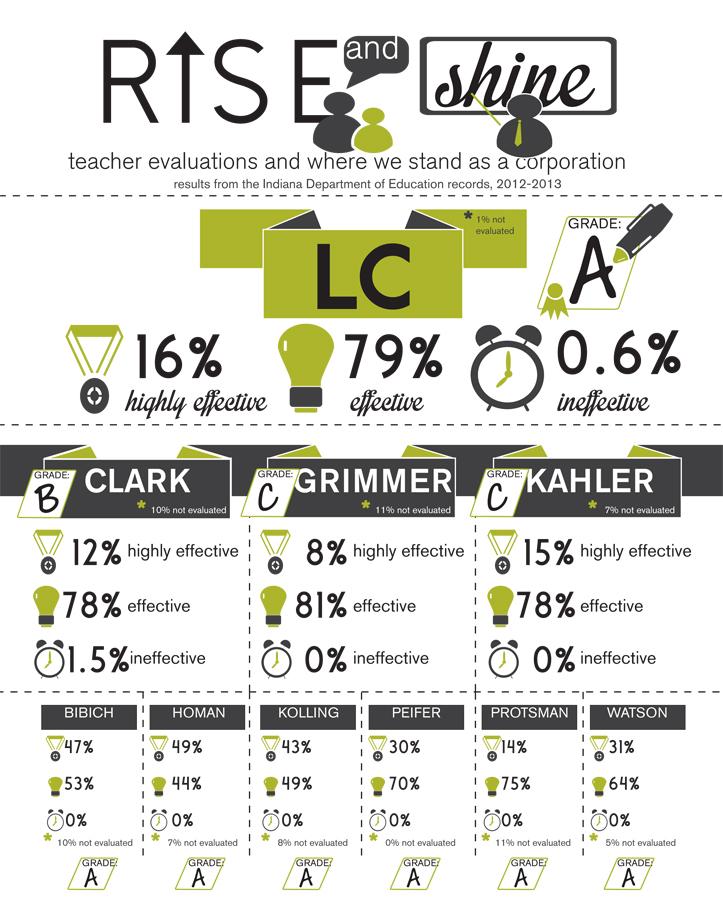RISE evaluation results released
April 15, 2014
The Staff Performance Evaluation Results for the 2012-2013 school year were posted to the public on the Indiana Department of Education website on Wednesday, April 4. These results include evaluations for high schools, middle schools and elementary schools in Indiana.
The system used to evaluate teachers in Indiana is called the RISE Evaluation and Development System. This program was developed by educators and is used to determine the effectiveness of Hoosier teachers. The 2012-2013 school year was the first year the IDOE has collected these results, but the system was developed in the 2011-2012 year.
When being evaluated, teachers are graded based off of a RISE rubric. The rubric consists of four domains: purposeful planning, effective instruction, teacher leadership and professionalism. Under each one of these domains are a number of competencies. In each competency, a teacher is given a score of four, three, two or one based on how well they meet each competency. After all the competencies are added from each domain, the teacher is given a score of highly effective, effective, needs improvement, or ineffective. All the evaluations are done by the administration and department heads of each school.
“[A rating is based on] the number of competencies that are shown during the evaluation. In order to be highly effective, you have to show all of the competencies in the effective area range. You have to also show some of the competencies in the highly effective [range],” Mr. Sean Begley, Freshman Center Principal, said.
The sections of the RISE rubric are very basic and standard. The competencies are clearly stated, and all an evaluator must do is decide at what level the competencies are reached by each teacher.
Some competencies, however, depend on how the students behave and perform in the class. Some teachers find this competency to be unfair because there is only a certain level a teacher can reach to control a student. For the most part, the teacher has no influence on what happens within a student’s life outside of school. However, this is not taken into consideration or reflected in a teacher’s evaluation results.
“Parts of [the rubric] are fair, and parts of it are unfair. I would change parts of the rubric so it wouldn’t necessarily be either a ‘yes’ or ‘no.’ There would be a continuum to go through and look at,” Mr. Joe Fox, Math Department Head, said.
These evaluations can be random or scheduled with the teacher. The procedure for a teacher is to continue teaching as if it were a normal day and no one was grading them. Evaluations are important to teachers because they would like to achieve a rating of highly effective or effective. If there is raise money available, a teacher must be rated effective or highly effective in order to earn the raise money; however, raise money is not always available to a corporation. The goals for teachers rated in the needs improvement or ineffective region are to try to become more effective for students by following a plan put in place by administrators.. Regular teachers who are not department heads have different views on the rubric they are being graded on.
“I think overall the rubric is [a fair assessment]. I would say the only issue I have with it is that because of the way the system is set up, [with] the 10-minutes-short evaluation, you really can’t get an idea of what the teacher perhaps [is] doing in 10 minutes. The longer evaluation, that makes more sense. I think trying to grade a teacher on what they are doing for 10 minutes out of 90 minutes, and not knowing when [an evaluator] is coming into the class, that’s a problem,” Mr. David Harnish, Science, said.
The RISE evaluation rubric and the Staff Performance Evaluation Results of 2012-2013 for Indiana high schools can be found on the Indiana Department of Education website.
To individually see the results of the Lake Central School Corporation, refer to the graphic attached.













